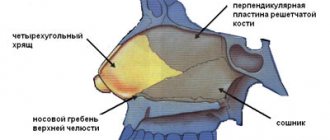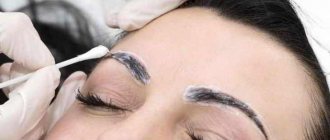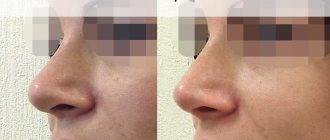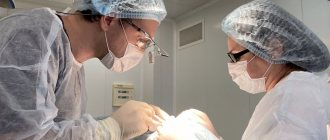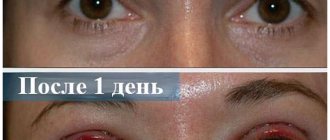Rehabilitation after plastic surgery
- an important stage of aesthetic transformation, which requires time and collaboration between the patient and the plastic surgeon. When recovery after surgery needs to be accelerated, for example, on the eve of an important event or going out, a cosmetologist can come to the rescue. An esthetician knows:
- how to relieve swelling after blepharoplasty;
- how to get rid of bruises after body liposculpture;
- how to get rid of visible scars after surgery
- ...and many other beauty secrets

We found out which beauty procedures will make the recovery process after plastic surgery on the face and body faster and more comfortable and have prepared this review for you.
During recovery after mammoplasty, facelift, blepharoplasty and other operations, it is important to follow all the surgeon’s recommendations
, consult with a doctor about procedures and care programs, do not forget about
dressings
and
follow-up examinations
. In combination with proper nutrition (proteins, antioxidants, enough clean water), rest, quitting smoking and alcohol (at least temporarily) - recovery in itself is faster. In some cases, the plastic surgeon prescribes additional medications - painkillers, a course of antibiotic therapy - so that recovery after plastic surgery is comfortable and without complications.
The restorative course of beauty treatments that we offer to our patients allows us to achieve the following results:
- get rid of swelling and bruises in a short time;
- reduce pain and discomfort;
- improve skin quality and its ability to regenerate;
- get rid of scars after surgery or make them less noticeable.
Rehabilitation after plastic surgery: why do we need special recovery programs?
You can find out more about recovery after mammoplasty, liposculpture and other aesthetic interventions on our website, and in more detail - at an appointment with a plastic surgeon
.
Hematomas and swelling after surgery, unfortunately, are inevitable. The minimum period required for tissue restoration after blepharoplasty and facelift is 14-30 days.
Rehabilitation after body surgery usually lasts 2 times longer. Of course, much depends on the specifics of the surgical intervention and the individual characteristics of the body.
Each patient always has a choice: to undergo an additional rehabilitation course or not. However, it is important to understand that rehabilitation programs are not only aimed at reducing rehabilitation or reducing pain. Electrostatic and lymphatic drainage massage, ultraphonophoresis and injection procedures have a beneficial effect on the skin at the cellular level. The restoration course is an excellent solution for those who strive for the best aesthetic result, want to take care of their skin and begin rehabilitation after plastic surgery with self-care, which is necessary to consolidate the impressive effect!
Rating of surgeons in St. Petersburg, according to patient reviews
Plastic surgery forums will help you easily select trusted specialists in different cities of the country. Thus, the ranking of the best aesthetic medicine clinics included 34 clinics from St. Petersburg.
They employ doctors who receive hundreds of positive reviews about their work:
- Tarasenko Vasily, has been practicing surgery for 18 years. Chief surgeon in the department of the international network of clinics "MediEsthetik" in St. Petersburg.
- Vetyugov Dmitry has 17 years of general surgical experience, of which 8 are in plastic surgery. He is considered one of the leading doctors in the multidisciplinary medical holding "SS-Clinic".
- Abramov Nikolay has been practicing surgery for 18 years, of which 15 have been in aesthetic surgery. Accepted at the Parada Center for Plastic and Reconstructive Surgery.
- Agapov Denis is a surgeon, an active member of the Society of Plastic, Reconstructive and Aesthetic Surgeons of Russia. Has been practicing aesthetic surgery for 19 years. Works as chief physician at Medici and Degas.
- Svetlana Aksenova has many positive reviews over her 5 years of practice in plastic surgery. Accepted at the multifunctional clinic "Mediler".
Rehabilitation after facial plastic surgery
Rehabilitation after a facelift (facelift), liposculpture and blepharoplasty is individual, but as practice shows, tissue restoration takes 2-3 weeks
.
During this period, bruises
and slight
swelling
, which increases
2-3 days
after surgery. Pain usually does not bother you and does not interrupt you from rest and daily activities; it can be reduced with the help of mild painkillers prescribed by your plastic surgeon. There is no need to worry about scars after a facelift and blepharoplasty - they are hidden in the natural folds of the skin or under the hair, and over time they will become invisible. If, during recovery after facial plastic surgery, a patient has an individual tendency towards hypertrophic, keloid, atrophic scars or the tissue healing process does not go entirely smoothly, cryodestruction of the scar, lipofilling or injection cosmetology comes to the rescue. Plastic surgeons at the Pirogov Clinic are always in touch with their patients. The key to successful recovery after facial plastic surgery is to follow all the doctor’s recommendations: for a while you need to give up warm baths, solariums, alcohol and smoking.
Rating of Moscow surgeons, based on patient reviews
Plastic surgery forums provide an opportunity to confirm trust in any clinic or plastic medicine center. Today, 94 Moscow clinics have received the title of the best in the country.
These medical centers employ trusted specialists who are trusted by thousands of patients:
- Yakimets Valery , 27 years of experience. Accepted at the Estet Clinic.
- Teplyashin Alexander , operates at Beauty Plaza, a plastic surgery and cosmetology clinic. Work experience – 35 years.
- Shah Gulnara , plastic surgeon with 31 years of professional experience, candidate of medical sciences. Accepted at his own clinic, Clinica Shah.
- Grigoryants Vladislav , has been practicing plastic surgery for 15 years. Currently receiving treatment at the Arbat Esthetic clinic.
- Grishkyan David , Doctor of Medical Sciences, 25 years of professional experience. He founded his own clinic - Doctor Grishkyan.
Facial lymphatic drainage
How to relieve swelling after blepharoplasty or facelift, and also get rid of bruises after surgery?
lymphatic drainage
will best cope with this task . This is a soft and painless procedure, the essence of which is manual or hardware impact on the skin in the direction of lymph flow.
A course of electrostatic and microcurrent drainage can be started 2-3 days after facial plastic surgery
- in accordance with the recommendations of the plastic surgeon.
Most often, to achieve the desired effect (quickly relieve swelling after blepharoplasty, get rid of bruises, tone the skin), 3 procedures
.
For those who strive for excellent results and want to take care of their skin, we recommend a course of 5 procedures
.
The effect of lymphatic drainage massage after blepharoplasty / facelift
- Tones the skin, improving blood and lymph circulation;
- Restores normal metabolism of nutrients in soft tissues;
- Improves the skin's ability to regenerate;
- Lifting the skin and muscle layer;
- Fights wrinkles;
- Models beautiful facial contours;
- Strengthens the effect of comprehensive facial rejuvenation;
- It has a general stimulating effect on blood vessels and epidermal cells and, as a result, quickly relieves swelling.
A course of restorative procedures after plastic surgery on the face reduces the recovery time by 2 times!
This means that after just 1 week, the visible consequences of surgery (swelling and bruising) will be barely noticeable or disappear completely, and your skin will look healthy and well-groomed.
Read more about the cost of a recovery course after plastic surgery
Stories of real patients with photos and videos have been published
In our world, the flow of information occurs spontaneously. To find out something specific, you need to sift through a large amount of information. The Plastic Surgeon website contains everything as informative as possible. And real stories are not published everywhere. And there are a lot of them here.
Many plastic surgery sites are carefully controlled by several surgeons. Negative reviews are deleted. Only good comments remain. There is one rule on the Plastic Surgeon forum - when posting a review, it is mandatory to post a photograph confirming this or that information.
If the rule is broken, your account will be banned forever. This is the right measure. How can strangers judge whether your information is true or false? There are only “before” and “after” facts. For those who do not want to post information about themselves, the necessary step is registration. Without it, many materials will be inaccessible.
Photo materials “before” and “after” all end up in the Gallery section. There are materials describing the work of surgeons – Russian and foreign; procedures - how to prepare, what medications, equipment should be used, consequences. Immediately before surgery, you can post a topic about the upcoming procedure. Administrators will recreate a model of the intended external appearance using Photoshop.
Sometimes topics with bad experiences are posted. The guys need support and sympathy. And for those who want to transform - the real experience of other people. Which may make you wonder - is the game worth the candle?
There is also a section on the forum with recommendations for care in dental, cosmetology or other areas where you can educate yourself.
Rehabilitation after liposculpture
Body liposculpture allows you to instantly get rid of “fat traps”, recreate an athletic profile and compensate for the lack of soft tissue volume (enlarge your breasts, buttocks). Liposculpture includes liposuction and lipofilling and is a minimally invasive operation (without incisions), since the surgeon performs all manipulations with a special cannula through small punctures in the skin. Our clinic has installed the latest vibration liposuction device PAL Liposculptor
, which makes such a serious and complex operation as gentle as possible - it eliminates damage to blood vessels, extensive hematomas, and bumps on the skin.
However, rehabilitation after liposculpture of the body cannot be called simple, especially if the plastic surgeon worked on more than 2 zones. After the operation, it is important to wear compression garments
, temporarily give up sports training (later it is not only possible to return to it, but it is highly desirable - to consolidate the result) and follow other doctor’s recommendations.
Immediate and early adverse events
As stated earlier, immediate adverse events develop within 24 hours after the procedure, early ones - in the period from 24 hours to 4 weeks. All complications of this group can be divided into two conditional subgroups:
- common (reactions at the injection site);
- actual adverse events associated with the procedure.
Local reactions to injection occur in connection with the procedure itself, which involves a traumatic effect on the tissue of the needle or cannula. In addition, the administration of the drug promotes tissue displacement, provoking these temporary reactions. This group of adverse events includes the following manifestations.
Hemorrhages
occur due to damage to small blood vessels along the movement of the needle or cannula; in addition, their appearance is associated with rupture of capillaries at the site of gel injection and increased vascular permeability due to the influence of the drug components [14]. According to the literature [15], hemorrhages more often develop with subcutaneous injection of material using the fan and linear technique than with supraperiosteal injection.
Hemorrhages can have different distributions: petechiae, ecchymoses, hemorrhagic impregnation and hematoma. Local reactions include only petechiae and ecchymosis. Clinically, the presence of blood under the skin is manifested by a change in the color of the skin at the injection site from purple to yellow-green. The dynamics are characterized by the evolution of hemorrhage with a change in color to yellow as the phenomenon resolves (blooming phenomenon). Clinical examples are presented in Fig. 4.
Rice. 4. Ecchymosis at the site of drug administration.
Clinical diagnosis of this adverse reaction boils down to a physical examination and is not difficult for specialists. If necessary, an ultrasound method and a clinical blood test can be used.
Minor hemorrhages (petechiae and ecchymoses) do not require mandatory therapy and resolve on their own within 7-10 days. In some cases, it is recommended to apply heparin ointment, gels containing arnica extracts (Traumeel S) 2-3 times a day to speed up healing. It is also possible to use fractional photothermolysis, which, however, will lead to a decrease in the volume of the administered drug. According to some data [16], pressure on the injection area reduces the risk of local hemorrhages.
Edema and erythema
also refer to typical reactions associated with the injection of fillers and arise due to compression of the capillaries draining the blood, injury and displacement of the tissues surrounding the drug, as well as the ability of HA to retain water for some time. These adverse reactions are manifested by hyperemia and swelling at the injection site (Fig. 5);
Rice.
5. Erythema at the injection site. their diagnosis is not difficult and is carried out clinically. Local cooling of the tissues immediately after the procedure helps reduce the severity of these phenomena. Erythema most often resolves on its own within a few hours, sometimes up to 7 days. Swelling may persist for up to 2 weeks. in some cases. Soreness
at the injection site is associated with compression of nerve endings by the drug and surrounding edematous tissues. The pain resolves on its own with a decrease in the severity of swelling and can sometimes bother the patient for up to 7 days.
Complications directly related to the injection of fillers require special attention and vigilance due to possible consequences. This group of immediate adverse events includes:
- hematoma;
- immediate hypersensitivity;
- reactivation of herpetic infection;
- vascular complications.
Hematoma
is a cavity filled with blood from a damaged vessel. This complication develops more often with deep injection of fillers than with superficial placement of the drug. Clinically manifested as swelling and hardening of soft tissues (fibrin clot), accompanied by moderate pain, possible signs of neuropathy and discoloration of the skin (Fig. 6).
Rice.
6. Hematoma at the injection site. Swelling and slight redness of the skin are visualized. The diagnosis of hematoma is made clinically by detecting the indicated signs and symptoms in the patient; ultrasound diagnostic methods can be used for confirmation (Fig. 7),
Rice. 7. Hematoma on ultrasound. A cavity in the soft tissues with echogenicity of blood is determined. MRI visualizing a cavity with blood-density fluid.
Often, the hematoma resolves on its own, but the risk of developing bacterial complications during its lysis remains high. For this reason, careful monitoring of the dynamics of the clinical picture is recommended as therapeutic measures. On the 6-7th day after the development of an undesirable phenomenon, lysis of the contents of the cavity begins, it becomes more liquid. To prevent purulent complications, it is recommended to puncture the hematoma during this period, followed by antibiotic therapy. In addition, it may be recommended to use hyaluronidase drugs (Longidase 1500-3000 IU at the site of filler injection once, repeat the injection if necessary) to reduce the volume of filler and accelerate the healing of the hematoma.
Immediate hypersensitivity reactions (IHT).
Allergic reactions are rare complications associated with the use of fillers. HA-based drugs are considered the safest in this regard [17]. At the same time, due to the presence of impurities associated with the synthesis of GC, the risk of developing immediate hypersensitivity increases significantly [18].
Clinically, reactions mediated by immunoglobulin E can manifest as local signs in the form of swelling, itching and hyperemia (Fig. 8),
Rice. 8. Erythema and swelling during an allergic reaction. and generalized (symptoms of anaphylaxis, Quincke's edema). In case of local reactions, it is recommended to use antihistamines for 3-5 days, it is possible to prescribe ointments with corticosteroids (hydrocortisone, applied locally 2-3 times a day) and the use of gyaulronidase (Longidase 1500-3000 IU at the site of filler injection once, repeat if necessary introduction). Generalized reactions require emergency treatment with the administration of glucocorticosteroids (prednisolone 30-90 mg intravenously, maximum daily dose 90 mg) [16].
Reactivation of herpes infection
occurs due to insufficient medical history or the patient’s concealment of information about his health. As is known, the prevalence of herpes virus type 1 (labial) in the population is up to 98%, however, not all patients receiving contour injection procedures have a risk of reactivation of the infection. More often, herpetic infections occur against the background of a subsiding or beginning exacerbation. The initial clinical manifestations include tingling, itching in the area of injection (usually perioral, less often on the nasal mucosa or hard palate); then the classic picture develops with papules evolving into vesicles, which subsequently open to form crusts. In the presence of filler, manifestations may be more pronounced; in addition, the formation of abscesses and purulent complications is possible (Fig. 9)
Rice.
9. Picture of reactivation of herpes labialis (swelling, erythema, vesicles). [19, 20]. In case of suspicion of the possibility of reactivation of a herpetic infection, it is recommended to prescribe short courses of antiherpetic drugs: acyclovir (Zovirax) 200 mg 5 times a day for 5-7 days of use, valacyclovir (Valtrex) 500 mg 2 times a day for 5 days, famciclovir (Famvir ) 1.0 g 2 times for 1 day. Specific diagnostics, as a rule, are not required; the diagnosis is made clinically. When an active infection develops, antiviral drugs are also prescribed (locally and systemically), most often requiring hospitalization of the patient [13]. Vascular complications
are often not divided into groups, but may have different pathophysiology, and therefore these adverse reactions are classified into occlusive and compression-ischemic syndromes. The main causes of vascular complications are considered to be medical errors, as well as the anatomical features of the patient’s blood vessels.
Occlusion develops as a result of damage to the vessel with a needle and the introduction of filler into its lumen, and is characterized by immediate development with the appearance of pain “at the end of the needle”, rapidly increasing swelling and blanching of the skin in the area where the drug was administered. In addition, vision impairment, including loss of vision, and stroke are possible. Occlusion of the angular artery can be fatal. Visual symptoms and acute cerebrovascular accident, according to some data, develop due to the ability of fillers to retrograde flow and pass through multiple arterial anastomoses, more often associated with injections in the upper third of the face [21]. It is believed that strokes develop due to gel entering the supratrochlear artery ( a
.
supratrochlearis
), which has anastomoses with the internal carotid artery through the ophthalmic artery (
a
.
ophthalmica
).
Compression-ischemic syndrome occurs when a vessel is compressed by filler without mechanical damage. Symptoms may develop over 24 hours and include slowly increasing swelling, local tenderness, and increased vascularity. Clinical signs of vascular complications are presented in Fig. 10.
Rice. 10. Occlusion of vessels of various locations.
Diagnosis is carried out clinically; ultrasound can be used to confirm and clarify.
In the development of vascular complications, there are several pathophysiological stages of tissue circulatory disorders: paranecrosis (initial processes of circulatory disorders, reversible), necrobiosis (irreversible disorders of tissue metabolism), apoptosis (programmed cell death), autolysis (cleansing of the lesion from dead tissue by cells of the immune system) (see Fig. 11).
Rice. 11. Pathophysiological stages of tissue circulatory disorders. Treatment is different at each sequential stage, and early intervention is directly associated with favorable outcomes.
Therapy should be started immediately when symptoms of paranecrosis are detected with the administration of Longidase by wide injection of the lesion up to 3000 units, the administration is continued over the next day, the maximum dose is up to 15,000 units [22]. In the future, with the development of necrobiosis, it is recommended to use anticoagulant therapy: low molecular weight heparins (Clexan 8000 IU/day) and antiplatelet agents (acetylsalicylic acid 125 mg/day, clopidogrel 75 mg/day). Clinical experience shows that the use of sprays and ointments with nitroglycerin can be effective (contraindicated in the perioral area due to the risk of systemic effects and the development of hypotension) and vascular agents (pentoxifylline (Trental) 400 mg/day intravenously), continued administration of hyaluronidase (Longidase). If the process progresses to apoptosis, antibacterial agents are added to therapy (ciprofloxacin (Tsiprobay) 1000 mg/day), Actovegin (800-1200 mg intravenously daily for up to 4 weeks). At the autolysis stage, it is possible to use physiotherapeutic methods to accelerate tissue healing (fractional photothermolysis, etc.).
In order to prevent the development of vascular complications, a number of measures must be observed. Proper knowledge of the topographic anatomy of the face and possible individual characteristics has a significant impact on reducing the risk of developing such complications. When selecting the injection site, consideration must be given to hazardous areas. It is recommended to use an aspiration test before injection. The use of thin and short needles and cannulas leads to a lower risk of perforation of the arterial wall.
In recent decades, the incidence of neurological complications
after filler injections. Most often, neuropathic disorders develop as a result of damage to the nerve with a needle, injection of filler into it, or compression of the nerve ending with gel. Nerve damage can be either transient or irreversible in some cases. Sensory, motor and mixed disorders are possible. The most commonly affected nerve is the infraorbital nerve.
Disorders of the function of the facial (Bell's palsy) and mandibular nerves are much less common, but these disorders can be persistent and last up to several weeks [19, 20, 23, 24]. The time for the development of adverse events varies from the effect at the end of the needle to a day or even several days.
Clinical manifestations include neuropathic (high-intensity) pain, allodynia, anesthesia, hypoesthesia and hyperesthesia, dysesthesia, paresthesia (feelings of goosebumps, tingling, cold and heat in the absence of an external stimulus), decreased muscle tone, increased tone of antagonist muscles. Examples from the author's practice are presented in Fig. 12.
Rice. 12. Motor neurological disorders.
The diagnosis is made clinically, taking into account data from magnetic resonance imaging and electromyography (Fig. 13).
Rice. 13. The use of MRI in the diagnosis of neurological complications of contour injection facial plastic surgery.
Treatment consists of a complex of interventions. It is proposed to use α-lipoic acid preparations (Berlition 300 mg per day for 2-4 weeks, Thioctacid 600 mg once a day for 2-4 weeks) intravenously, followed by transfer to oral administration for 1-3 months. It is recommended to use neurovitamins (Neurobion 2 tablets per day for 10 days, Milgamma 2 tablets per day for up to 4 weeks) and venotonics (Detralex 2 tablets per day for 4 weeks, Phlebodia 1 tablet per day for up to 2 months). Symptomatic treatment of neuropathic pain is carried out with the use of amitriptyline. It is also possible to use short courses of high doses of corticosteroids (prednisolone 1 mg/kg orally for up to 5 days) [25]. Some experts suggest the use of physiotherapy and acupuncture, but the effectiveness of these interventions for neurological disorders is questionable. In addition, the authors recommend the use of botulinum toxin to reduce the tone of antagonist muscles in the area of motor nerve damage.
Effect of lymphatic drainage after liposculpture
- Tones the skin and muscles, improving blood and lymph circulation;
- Restores normal metabolism of nutrients in soft tissues;
- Improves the skin's ability to regenerate;
- Fights cellulite;
- Models slender and toned figure contours;
- Relieves swelling and bruising;
- Promotes rapid healing of cannula marks;
- Helps consolidate and improve the results of body contouring surgery.
After body liposculpture, a course of 5-8 procedures or more is recommended so that you can evaluate the result and return to an active life as soon as possible.
An undoubted advantage of the site is free promotions.
Conducted by administrators with some specialist. Subjects - different - detailed transformation - rhinoplasty, mammoplasty or correction of the whole body. There is one condition - to be in the public eye - to provide reporting at each stage of transformation. The results are summed up by collecting votes. Perhaps the surgeon will choose the winner himself or with the help of a general vote among members of the forum. It is not necessary that there will be only one winner.
Another interesting point is the demonstration meetings among the forum participants. Basically, they are held in both capitals of our state. The purpose of this kind of event is a personal meeting, discussion of certain procedures, recommendations and advice for “newbies”, demonstration of personal experience - appearance. For the meeting, a cozy cafe is rented, a time convenient for everyone is agreed upon. You can choose a specialist, an institution, based on the experience of real people.
The main advantages of the Plastic Surgeon forum:
- — holding free events;
- — real reviews from ordinary people;
- - useful communication;
- — a large amount of information is concentrated in one place;
- — truthfulness.
When can injections be given?
PRP therapy (plasmolifting)
Skin restoration after plastic surgery on the face is facilitated by PRP therapy (plasmolifting)
.
Swiss plasma lifting RegenLab
is today considered the “gold standard” and one of the world leaders in injection cosmetology. Facelift (surgical facelift) eliminates deep wrinkles and ptosis of the face, but in itself it does not affect the quality of the skin. PRP therapy (plasmolifting) saturates the skin with platelets, triggering at the cellular level the processes necessary for rejuvenation from the inside (stimulates the synthesis of its own collagen, elastin, hyaluronic acid).
Do plasma lifting
it is possible already
3-4 weeks
after plastic surgery, sometimes earlier - it depends on the specifics of the surgical intervention, the recommendations of the plastic surgeon and cosmetologist.
PRP therapy
works well with facial lipofilling
, as platelet-rich plasma improves cell survival.
Rating of surgeons in regional centers, according to patient reviews
The People's Rating of Plastic Surgeons is the most reliable indicator of successful activity in aesthetic medicine.
In Kaliningrad there are 14 doctors, according to reviews, the following are considered top:
- Ignatenko Alexey , 13 years of experience;
- Vuylov Maxim , work experience - 14 years;
- Bakhtiyarov Oleg , plastic surgeon of the highest category, 44 years of experience.
According to popular vote, a rating of plastic surgeons was compiled in Krasnodar.
Out of 35 doctors, the top three included:
- Oktyabrsky Mikhail, plastic surgeon at the Zdrava clinic, has 20 years of experience.
- Maloletkin Sergey , plastic surgeon of the 1st category, 10 years of experience.
- Markushin Alexander , surgeon, 12 years of experience, doctor at the Chalet Sante clinic.
In Yaroslavl, the rating of plastic surgery is headed by:
- Shirmanov Pavel , plastic surgeon of the 1st category at the Dynasty clinic.
- Sharapov Ilya , surgeon at the Dynasty clinic with 6 years of experience.
- Novikov Mikhail , a plastic surgeon with 25 years of experience, accepts medical services.
Don’t miss the most popular article in the section: Vera Alentova after plastic surgery - the latest photos, what operations were performed, how the star has changed.
